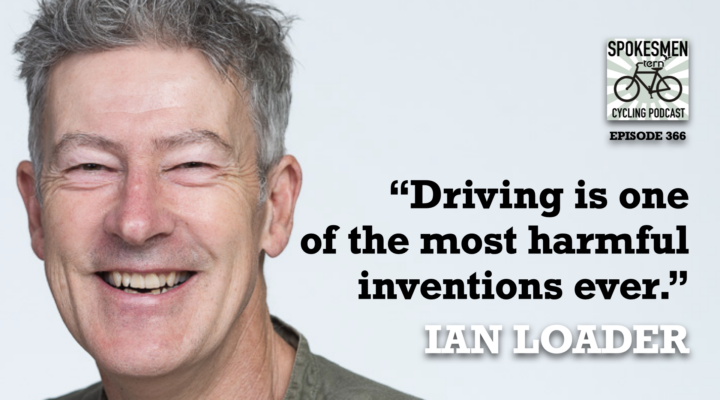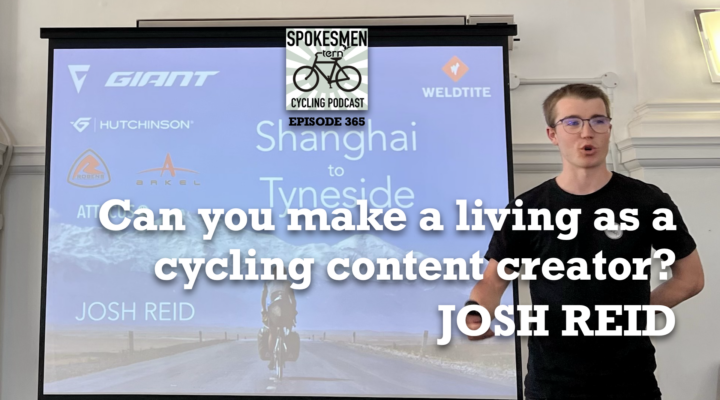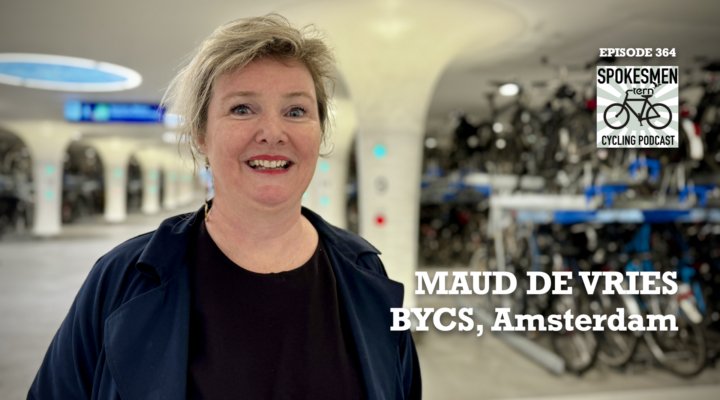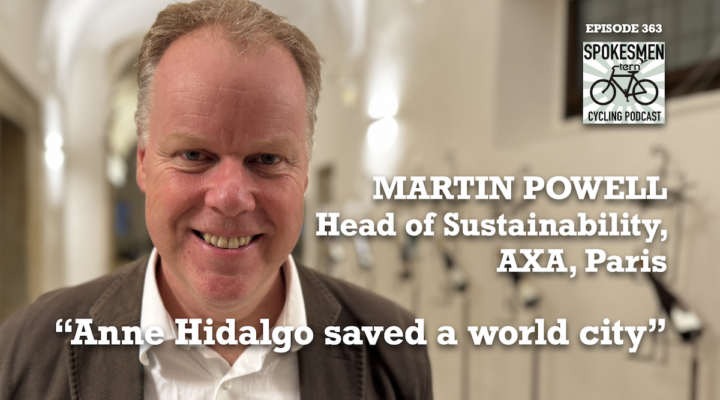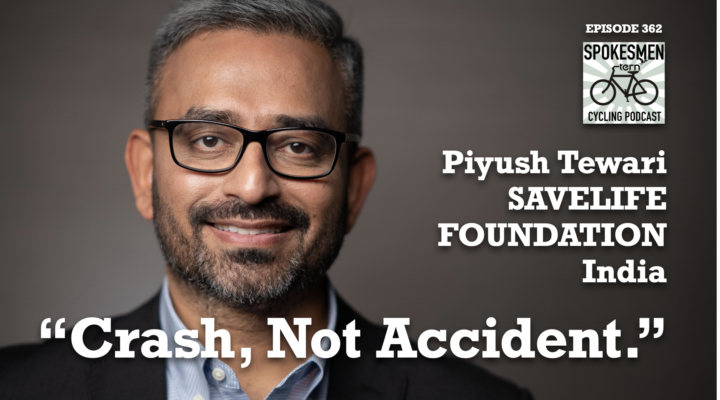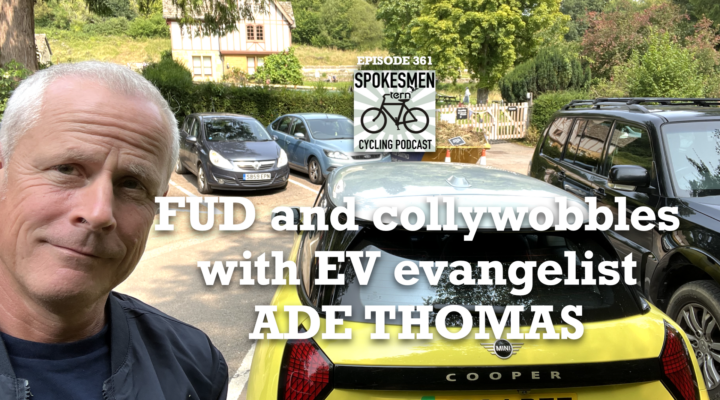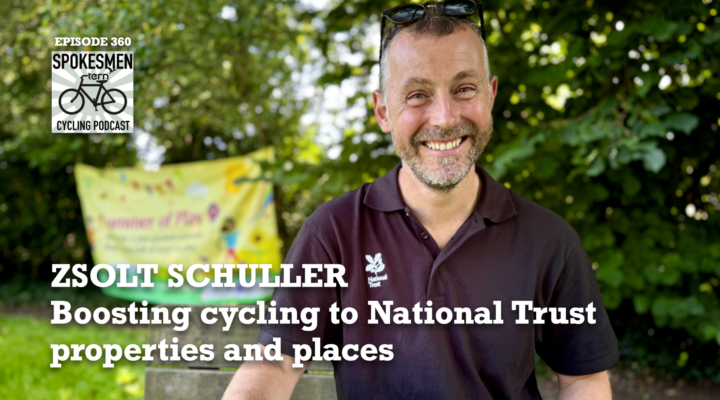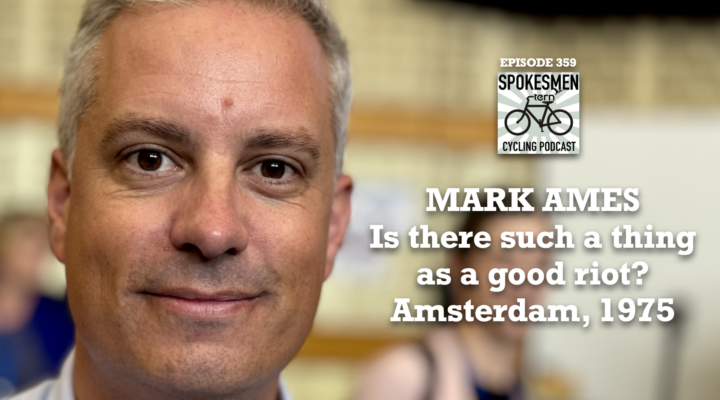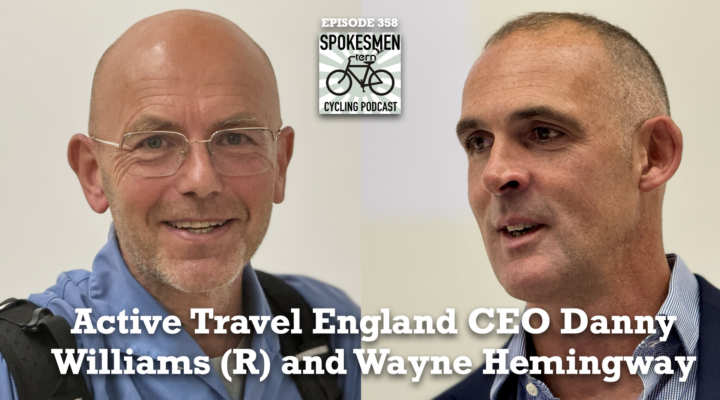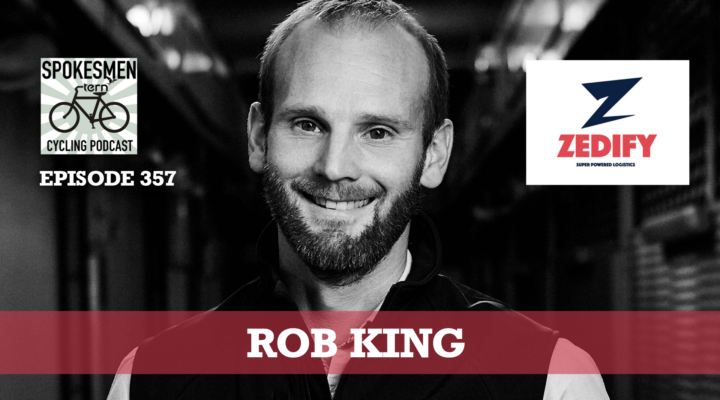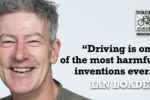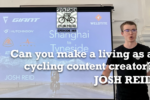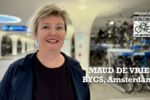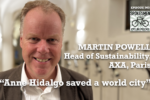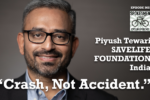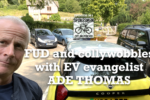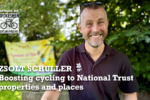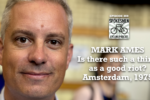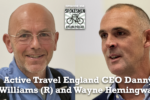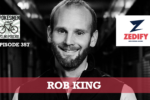21st November 2023
The Spokesmen Cycling Podcast
EPISODE 343: Mr & Mrs McAleese moving to Oz
SPONSOR: Tern Bicycles
HOST: Carlton Reid
GUESTS: Philip and Irene McAleese of See-sense
TOPICS: Philip and Irene McAleese of See-sense, the Northern Irish bike lights and data company, are upping sticks and moving down under. We also talk V2X beacons, Cycling Industries Europe, Kevin Mayne, Jon Parkin, Velo-city and Geordie accents.
MACHINE TRANSCRIPT:
[00:00:00] Carlton Reid: Welcome to episode 343 of the Spokesman Cycling Podcast. This show was recorded on Tuesday, 21st of November, 2023.
[00:00:29] David Bernstein: The Spokesmen cycling roundtable podcast is brought to you by Tern bicycles. The good people at Tern are committed to building bikes that are useful enough to ride every day and dependable enough to carry the people you love. In other words, they make the kind of bikes that they want to ride. Tern has e-bikes for every type of rider. Whether you’re commuting, taking your kids to school or even carrying another adult, visit www.ternbicycles.com. That’s t e r n bicycles.com to learn more.
[00:01:04] Carlton: the last episode, I said this show would be an interview with Komoot of Germany, but then an Australian angle intervened. Philip and Irene McAleese of See.sense, the Northern Irish Bike Lights and Data/data? Company, are upping sticks and moving down under. I’m Carlton Reid and regular listeners will know that Philip and Irene have been on the show multiple times, so it’s only fitting that I invited them for a wee chat before they depart at the beginning of December.
[00:01:40] Carlton: So what convinced you to exchange the reign of Northern Ireland For the sunshine of Brisbane.
[00:01:48] Irene McAleese: Oh, well. Really a mixture of things. Obviously, you know, I’m Australian. I’ve been away now for 20 years. Next, in April of next year, I’m coming up to 20 years. [00:02:00] Um, and I think it was actually when I was back home, um, last year, my, my dad wasn’t well and I went back, um, for that.
[00:02:08] Irene McAleese: Um, but it just sort of, I don’t know, something just sort of, um, In my mind just thought I wanted to be back, I wanted to be closer to my family, but also we were really impressed with What’s happening in Australia? It seems to be sort of post COVID. There’s a lot of energy around Active travel, there’s a lot going in in terms of investment They seem to have more funding pots available for this kind of stuff And yeah, we like the, you know, we liked what What’s happening in the energy of the, the, um, in Australia at the moment and the, um, you know, the economic potential as well.
[00:02:46] Irene McAleese: So yes, weather is certainly a, a factor, but, um, we do see opportunity to expand CSense in the Australian market.
[00:02:55] Carlton: Yeah. I’d like to get into that in a, in a, in a bit, because that’s clearly going to be [00:03:00] a phenomenal, uh, task ahead of you. And you can tell me about exactly the structures you’ve put in place, but first of all, uh, A bit more personal, really, in that, you’ve clearly, you’ve, you’ve, you’ve visited Irene every couple of years.
[00:03:15] Carlton: Is that, is that right? Like, to go and see your family and, and, you know, pandemic withstanding, you’ve kind of, you’ve been there regularly. So I’m assuming your kids, it’s not going to be like totally alien for them. They’ve also seen Australia. And, and, and what is, is in their future.
[00:03:33] Irene McAleese: Yes. However, I am trying to kind of get across that, you know, every time we’ve been back for holidays, it’s…
[00:03:39] Irene McAleese: It’s the beach, it’s barbecues, it’s social events, it’s family. They have this very rose tinted view of what life in Australia would be like. So I’m trying to get across that there’s actually going to be a lot of grunge stuff as well. Like, you will have to go to school.
[00:03:55] Carlton: You
[00:03:55] Irene McAleese: will still need to do homework.[00:04:00]
[00:04:00] Irene McAleese: So, you know, um, yes, I, I think that, I think that they are excited, but yeah, I mean, as with anywhere you live, you make the best of where you are. And I’ve actually really enjoyed everywhere I’ve lived. I’ve lived in Northern Ireland for 11 years. I’ve lived in Singapore. I’ve lived in London. Um, I really, you know, I, I always think that you can make the best of wherever you are.
[00:04:24] Irene McAleese: And it’s very much about your attitude and also just being around good people. So how old are your kids? Our kids, well we have, our youngest is actually turning 12 this week, and our eldest is 14. So part of the reason of, I guess, wanting to go now is to get them into the school, for the, get them a little bit embedded into the school before they get too senior, um, and start to get into the later years, so.
[00:04:52] Irene McAleese: I guess in an ideal world, we might have liked another a year or two to sort of, um, um, [00:05:00] prepare for the move, but really once the decision was made, we ripped the bandaid off quickly, um, and decided to do it.
[00:05:08] Carlton: And Philip, talk, talk to me about this. So, I mean, you know, Irene’s obviously spent 20 years away from Australia.
[00:05:16] Carlton: Is this like a quid pro quo thing? You know, you’ve spent 20 years away. All right, let’s go and spend 20 years in Australia. How have you, how have you negotiated this as, as part of your, your marriage kind of contract?
[00:05:29] Philip McAleese: Yeah, so we were living in Singapore and obviously we had to make the decision between Northern Ireland and Australia when we decided we wanted a bit more family support.
[00:05:36] Philip McAleese: Um, my family are all quite local to where we are here. Um, whereas Irene’s family were dispersed around Australia, uh, which is a really, really, uh, unfathomably big place for Europeans. And, um, so it made sense to come here first. We always said that we would retire in Australia. Um, we’re, we’re just going a little bit sooner than we expected.
[00:05:57] Philip McAleese: Um, just to fit in really with. It’s the equivalent [00:06:00] of GCSEs A levels and not disturbing schooling too much. Um, and, and plus I’m really excited about it. I mean, there’s a lot of opportunity for us down there. Um, and you know, some of our bigger, biggest projects are happening right there at the moment. And so it’ll be really good to go down, um, and to be there, to be able to accelerate and leverage.
[00:06:20] Philip McAleese: Um, all of that goodwill we have already. So
[00:06:22] Carlton: is that project the one that you’re doing with, uh, Victoria’s TAC, Transport Accident Commission, the Light Insight Trial? Is it that one? Yes, it’s
[00:06:30] Philip McAleese: actually an extension of that trial. So that trial wrapped up, um, last year. Um, but we were delighted that they chose to extend the project working directly with TAC.
[00:06:39] Philip McAleese: Um, and now we’re working with, uh, the first LGA, local government authority, um, called Surf Coast. Um, who are just a little bit, um, south of Melbourne. Um, they’ve got some infrastructure going in and they’re very interested in understanding the before and after and seeing what impact of change they can have.
[00:06:58] Philip McAleese: Um, they’re really [00:07:00] interested in community engagement and lots of the great things that our data can really help to, um, facilitate and help them do. Um, and that should lead on to projects with other, um, LGAs as well. There are a number of them interested and I’m talking to the TAC at the moment, um, and it would be fantastic to see, um, what we can do to help them
[00:07:18] Carlton: as well.
[00:07:18] Carlton: Because Australia, from, from this side of the, the kind of the antipodes, it’s always seemed a bit backward in, in cycling in that, you know, certainly Europe, continental Europe, and even the UK for a few years. Seem to be far in advance of Australia and Australia seemed to be going backwards on active travel But what you’re saying or what what what I was saying a few seconds ago was maybe that’s changing.
[00:07:43] Carlton: Yeah,
[00:07:44] Irene McAleese: we’re seeing I definitely think that there is There does exist in Australia this Us and them, you know attitude of cycling. I mean it does exist Um, I’m not sure if that’s something that’s going [00:08:00] to be introduced here as well to an extent. But, um, that’s what I was saying though, Carlton. I think that I sense that the attitudes are changing.
[00:08:07] Irene McAleese: There’s definitely a lot more investment in infrastructure that has gone in. Melbourne and Sydney, but also in Brisbane in my hometown, I was really impressed to see even in some, even in, uh, you know, there’s urban investment in urban areas, but also rail trails, they call them, which are like the Greenway investment for tourism and things like this.
[00:08:33] Irene McAleese: Um, yeah, it’s, it’s, it’s really, um, it’s. It has really taken off in the last few years. I think particularly since COVID, there’s been, there’s been a big uptake. They, um, they still have a long way to go. Um, but I’m seeing that there’s a lot more appetite. Um, and I’ve been speaking with other Australians at the, it was a large contingent of Aussies at the VeloCity in Leipzig this [00:09:00] year, there was a really active, um, um, advocacy groups there, um, the Amy Gillett Foundation and, and WeRide and the Bicycle Network, they’re all doing fantastic work, um, there’s, there seems to be.
[00:09:14] Irene McAleese: You know, the likes of the people that we have been engaging with at the Transport Accident Commission and the iMove project. I mean, we work with people on projects around the world and some of the people we’re working with there we really think have great minds and a real appetite for innovation. Um, so.
[00:09:33] Irene McAleese: Yeah, we’re really happy to, to explore that and see what we can do, um, to help push.
[00:09:40] Carlton: And how much of the, this may be this expansion of interest in active travel, how much of it is perhaps due to climate change? Because again, from the perspective from this side of the Antipodes is certainly the, the previous crop of Australian politicians have been all dinosaurs.
[00:09:57] Carlton: They were all just totally denied the fact that [00:10:00] man made climate change. Uh, is happening at all? Are the current crop
[00:10:04] Irene McAleese: better? Yeah, they’re, I mean… Well, I think that the current Prime Minister has acknowledged that climate change is a thing, so that’s, that’s definitely a start. I think that, yeah, there’s definitely an awareness in Australia now more so than in previous years about the need to make change and to do it, do it rapidly.
[00:10:24] Irene McAleese: Um, so I think that definitely could be, could be a factor. Um, I think there was a report actually that came out, um, just this week about, about the cycling industry and its contribution to the economy. So it was, it was really interesting that one of the questions that they asked people as to why they’re riding their bike, um, the reason why.
[00:10:49] Irene McAleese: My highest reason was for their own fitness and well being, but one of the second highest reasons I think was about concern for the environment. So it must be playing [00:11:00] on people’s minds.
[00:11:01] Carlton: And then logistically, your business, I mean, let’s just, you’re not closing your business down. You are operating it as a satellite.
[00:11:11] Carlton: So you’re going to be opening a sales office in Brisbane. And expanding in Australia, because what currently do you have in Australia? Is there anything at all in Australia or do you just sell your products and your services there? And that’s it, and you do that from the Northern Ireland? Yeah, um, we
[00:11:26] Philip McAleese: do exactly what you say.
[00:11:27] Philip McAleese: So we’re setting up a sales office there. Um, all of our projects are, uh, have been run and executed really from, from here. Um, we did visit, um, the Transport Action Commission in Melbourne. Um, and we spent the day with them on our last personal visit to Australia. Um, and we found that to be incredibly useful and really, really rewarding.
[00:11:48] Philip McAleese: Um, and so we realized that it was a good opportunity to do a lot more of
[00:11:52] Carlton: that. Previously I’ve asked this, this, this question, and maybe it changes every few months anyway. Because you started as a light [00:12:00] company, and yes, it was a clever light, but it was a light company. And then each time we talk, it’s the data, data thing, uh, with Irene and with you, the different ways of pronouncing it.
[00:12:09] Carlton: Um, you seem to be becoming much more of a, a, a, data company. Has that accelerated even just in the last, you know, six months since we last talked? Um,
[00:12:18] Philip McAleese: I think we, we’ve not really changed our focus. I think probably what has changed is that, um, you know, with projects like, uh, in Denver and in Australia, um, and in Essex, we’re seeing real infrastructure changes be put in.
[00:12:33] cPhilip McAleese: So I think we finally got to the point where, um, you know, appetite and willingness and I guess understanding of data, um, has advanced to the point where it is now being actively used, which we’re super excited
[00:12:46] Carlton: about. When you are in Australia in your new sales office, you are selling lights or data?
[00:12:51] Philip McAleese: Oh, very much data.
[00:12:52] Philip McAleese: Yeah. So, I mean, the lights are fantastic. They’re really good at a personal level. We think for helping to make you more visible, [00:13:00] um, as you ride around, which should hopefully lead to a better riding experience. Um, but ultimately the bigger benefit we can have is around understanding, um, the, the greater pool of cycling.
[00:13:11] Philip McAleese: So, you know, where is the infrastructure working well and where can we help the cities to understand where it can be improved? Um, and we’re starting to look at other things, you know, there’s a lot of initiatives going on with things like green waves. Where, um, you know, they put beacons or transponders on the bikes and allow them to have green traffic lights all the way through their destination.
[00:13:31] Philip McAleese: Um, we like that idea in principle, but of course you can’t have a beacon on every bike. And so it doesn’t really provide, um, you know, a fair experience to everyone. Whereas when we look at our data, we only need a sample of cyclists in order to be able to model, to understand. Where the bunching of cyclists occurs, where the biggest delays and the highest probabilities are of being stopped at a set of traffic lights.
[00:13:55] Philip McAleese: And then through that modeling, we have the city to understand, you know, what, [00:14:00] what changes need to be made to traffic phasing to allow for these bunches or groups of cyclists that have naturally formed in the environment to get collectively a green wave all the way through. without having to have any additional sensors on the bikes themselves.
[00:14:14] Carlton: All right, Philip’s brought up beacons there. I, I wasn’t going to bring it up, even though you know that I probably was going to. Um, so, so, so beacons was mentioned at a certain safety conference you were at in, was in the Hague just recently. And it was, it was, it was Gazella. So it was like somebody from Gazella basically saying cyclists of the future are going to have force fields.
[00:14:36] Carlton: Um, you know, this, this, this. This, this, you know, beaconization program, uh, was it, was it swallowed whole by the audience or was it quite, was there groans when even Gazelle, alike, seemed to have, uh, swallowed the Kool Aid? Well,
[00:14:52] Irene McAleese: I, I would say that it was, you know, this is an academic audience who, um, you know, this is the international [00:15:00] Cycling safety conference.
[00:15:01] Irene McAleese: Um, the audience, um, primarily academics who are focused on research and they like the idea of testing out ideas. I think one of the things that, you know, one of the key things that the audience really noticed straight away was that the coalition for safety, I think it’s called the organization which has been set up, didn’t have any.
[00:15:25] Irene McAleese: Um, voices on that coalition from the academic world. Um, so that was, I think, the number one point of view. Now, to be fair, Gazelle did say, well, we would like to invite those voices on now, but it had originally come from being an industry driven thing. So I think that was the first point of, you know, why are you developing this in isolation without taking on the, the ideas, the insights and, you know, Perspectives the academic, um, world could potentially offer, [00:16:00] um, in helping to shape or steer the solution.
[00:16:03] Irene McAleese: Um, and there were other also other questions that that came up about. Um, why, you know, um, would this give a cyclist a sort of sense of false sense of security that they felt that they were riding in a bubble? I think that was actually the picture on the first slide. There was a picture of a cyclist enclosed by this, by this bubble of safety.
[00:16:31] Irene McAleese: Um, that, um, you know, and I think there was immediately some reaction to that. Um. And your ears must have been burning, Carlton, because yours truly did put up my hand and say, Have you read Carlton’s fantastic piece in the Forbes about this? You know, I think that there’s, you know, there are some valid points here around equity.
[00:16:52] Irene McAleese: Um, but yeah, there were actually a couple of people in the audience as well that, that, you know, didn’t seem opposed to it. Seemed, [00:17:00] you know, open to it, but wanting to test and validate that actually this could. Does this work? And I guess that’s coming from the researcher point of view, you know, appetite to validate or test things without sort of completely ruling it out.
[00:17:15] Irene McAleese: And I think that, um, to be fair to Gazelle, they acknowledge that there’s definitely a lot more work to do to be able to validate. If this does actually bring benefit, and it was kind of presented as very much a work in progress. I
[00:17:31] Carlton: mean, I welcome technology. I’m talking to people here who are right, the cutting edge of bicycle technology in data and in digital diagnostics, so I’m not against this.
[00:17:45] Carlton: But I’ve got a bikes that sometimes have the Garmin radar. And you very quickly get used to that and, and you almost stop looking behind and you just rely on, on [00:18:00] your, your dashboard to tell you how many cars are coming, which is great when you’re on that bike. But then if you’ve got like a few bikes, which, which I have, I’m lucky enough to have quite a few bikes, you switch to a different bike and you’re still in that kind of, I’m going to rely on the technology mode.
[00:18:17] Carlton: And then all of a sudden it’s like, yeah, but you’re not on that technological bike anymore. You’re on a naked bike all of a sudden. So you’ve got to go back to the old ways. So it’s, it’s almost like the, the, you know, self driving cars. If you have, you know, 10 years of sitting in a car and you’re not having to touch anything, all of a sudden you have to use, you know, your driving skills.
[00:18:39] Carlton: It’s just a little atrophied. And it’s the same with, with, with, with technology. If we start relying on technology. on bicycles too much, like the, the Garmin Varia radar, all of a sudden you’ve lost all of those actually pretty good skills. And that’s not even, as you mentioned, equity there. You’ve got a whole bunch of, you [00:19:00] know, 99.
[00:19:01] Carlton: 9 percent of the population ain’t going to have this technology. It’s for the rich people will have this technology. And why should we sacrifice, why should the rich people be protected and, and everybody else not be protected? So there are huge, the academics, if you’re, you know, talking about academics, I would quite like there to be some historians, not just tech academics, but historians there, social historians, you know, people, academics who are specialists in, in, in genuine.
[00:19:31] Carlton: equity to bring all of these perspectives because that’s that is up from what I can see is totally being ignored.
[00:19:37] Irene McAleese: And yeah, they’re currently not on the coalition for safety. Panel at all so that that perspective has not been brought in which is a real miss That’s definitely something that the audience caught out The other thing that they also said is how would this work in the Netherlands with you?
[00:19:53] Irene McAleese: Detecting bikes and there’s thousands of bikes Um, anyway, Philip, you were going to [00:20:00] say something. Yeah, I
[00:20:01] Philip McAleese: think it’s interesting as well, because if you look at sort of the agenda, who’s driving it, um, obviously there’s both, you know, car and bicycle companies, um, promoting this as an idea. Um, but really when you look at it, um, at the technologies that they’re using and trialing and evaluating.
[00:20:17] Philip McAleese: Um, it’s largely based around car based systems of V2X. And so a lot of those are by companies like Qualcomm, um, who will be not just in one manufacturer, but will be in multiple cars. And the argument is that, you know, because it’s in multiple cars, um, it can be upgraded over the air in the future to allow the cars to detect.
[00:20:37] Philip McAleese: other things that have V2X on them. Um, but it’s fundamentally, um, I think they’re trying to retrofit a technology which is too expensive for bikes. Um, and as you say, we’ll end up only in the most expensive bikes because it’s, uh, it’s an expensive chipset. It requires a lot of energy, which in turn needs a big battery.
[00:20:54] Philip McAleese: Um, and so it’ll tend towards high end e bikes and that sort of thing. And, [00:21:00] you know, there are cheaper technologies out there, but it would require more More money being invested into the car, which again, changes the economic value. So the thing that I think is quite good, and I’m actually reasonably excited about is, um, the likes of Euro end cap and the Australian equivalent end cap.
[00:21:18] Philip McAleese: And since 2010. Sorry, 2020. Um, they’ve had tests around autonomous braking and detection of cyclists. Um, most recently in 2023, both of them have announced that, um, dooring or prevention of dooring is part of their scoring system as well. Um, and that’s kind of interesting because although these tests are, you know, independent of the car manufacturer, um, they do kind of.
[00:21:45] Philip McAleese: Uh, reactor, or I guess we’re set up as a result of things that are present in the cars. So, for example, the dooring, um, one of the first cars that was available to do that was the idea for back in 2016. So, you know, getting on for 7 year old technology. [00:22:00] And indeed, I believe that uses very similar technology to the Garmin Varia.
[00:22:04] Philip McAleese: Um, of a radar based system looking behind to look for bicycles. So it is possible to do this stuff without needing, um, you know, really expensive V2X technologies that is being, um, proposed. Um, I guess on the flip side to, to be fully, um, I guess cognizant of all the different factors, um, you could argue that.
[00:22:25] Philip McAleese: Um, how well do these systems work in the real world, the, you know, they certainly work well in testing and a lot of cars do pass, um, the standards for the test. Um, but we know from emissions regulations in the past that it is possible to set up a car to do a very specific thing and the real world, it might not behave exactly the same way.
[00:22:45] Philip McAleese: So given that the car manufacturer is saying it’s really hard to detect a bike, but the cars are passing these Euro NCAP standards. Um, I think we probably need something more, more like we have an air traffic control. So my, my first job was an ATC. [00:23:00] And if there’s a crash with an aircraft, it gets independently investigated, um, a report is published and everybody learns from that.
[00:23:07] Philip McAleese: Um, of course, that doesn’t happen with cars. And, you know, if a car has a collision. Uh, I should say if a car, if there’s a collision, not necessarily the car’s fault, unless it’s self driving, of course. Um, but where does that information go, you know, at best back to the manufacturer to improve their own system.
[00:23:23] Philip McAleese: So, um, you know, how do we get some of that knowledge and spread it around the car industry so that everybody can learn from it as
[00:23:29] Carlton: well? We’ll talk about data here. And if you’ve got a company that. Is now more data than it is just pure, just, uh, physical product lights. Um, even though your chips are being used, presumably that means it’s been easier for you to make this decision to move you and your family, uh, and set up a sales office in Australia.
[00:23:53] Carlton: Because you’re not really doing physical distribution of products if you’re doing data. We,
[00:23:59] Philip McAleese: [00:24:00] we do still have a reliance on the technology. So, um, a lot of what we do and our secret sauce is around the processing we do on the devices, um, which is unique to us and give us so much data, much deeper, richer insights than would otherwise be available.
[00:24:14] Philip McAleese: Um, The, the fortunate thing, I guess, with our technology is it is relatively small. Um, you know, we can take a box of 100 or 200 lights and send them to wherever we need to, anywhere in the world. Um, we’re very fortunate as well that because it tends to be viewed as safety technology, it tends to be free from, um, duty and import taxes, which, um, slow things down and complicate the processes.
[00:24:36] Philip McAleese: So actually we’ve, well, we do have a reliance on some logistics. Um, it’s perhaps not as challenging as some other companies. It allows us to, to work around it relatively
[00:24:45] Carlton: easily. So after, I’m going to cut to a commercial break now with my colleague, David, but after the break, I’d very much like to, uh, talk about logistically, how you’re going to do it.
[00:24:54] Carlton: And then I’d like to bring Irene again and, and, and, and talk about, um, her role [00:25:00] in the industry and, and how maybe she’s going to replicate that in Australia. But first of all, let’s go across to David in America.
[00:25:09] David Bernstein: This podcast is brought to you by Tern bicycles. The good people at Tern understand that while a large cargo bike can carry oodles of stuff, many of us prefer something a little more manageable. That’s why they’ve come up with the HSD e-cargobike for folks with big aspirations to go car free, delivered in a compact size, with its rear shock, 280 kilos, and a combined hauling capacity of 180 kilos. The robust new HSD is stable and easy to manoeuvre, even when under load. And with its Bosch eBIKE SYSTEM tested and certified to meet the highest UL standards for electric and fire safety you’ll be able to share many worryfree adventures with a loved one whether it’s your kiddo or Nan. Visit www.ternbicycles. That’s te r n turn bicycles.com to learn more
[00:26:09] Carlton: So, thanks David, uh, in America there, but we’re not talking about America. We’re talking about Australia with Irene and, uh, Philip McAleese.
[00:26:19] Carlton: So, tell me exactly how you’ve embedded yourself, very successfully, In the industry across here in, in, in Europe, um, specifically cycling industries, Europe. So tell me about the role. on, on, on the board. Maybe start by telling us what Cycling Industries Europe is.
[00:26:37] Irene McAleese: So, Cycling Industries Europe is, is the industry group which is being set up to, um, advocate for industry, but also really recognising that, um, you know, there’s a lot of work actually done to sort of advocate for investment in cycling infrastructure because most of the cycling [00:27:00] brands recognize that more investment in that helps to get more people on bikes, which ultimately helps all of the brands.
[00:27:08] Irene McAleese: So it’s not just bike brands actually over the years. It’s, it’s, it’s sort of broadened out. So the whole remit of the cycling industry is company like ours, which are offering. You know, um, accessories and data and services. There’s also other companies looking at maintenance, a whole range of different kind of support industries as well.
[00:27:28] Irene McAleese: Let’s do it around the main bike sales. Um, it’s actually an offshoot of the European. Cycling Federation, ECF. So years ago, it was part of that and then it sort of split out from that, but actually provides a lot of funding and support back to the ECF. Um, I did, uh, we were actually proud to be a member of the ECF or the, um, the CIE back when it was still part of the ECF actually.[00:28:00]
[00:28:00] Irene McAleese: And, um, one of the reasons I joined at the time was because I came across Kevin Mayne. Actually, it was through one of the articles that you had written, Carlton, where I’d seen that. Um, and when I met Kevin, I, I met Kevin at the first, It’s the first VeloCity I attended in Taipei and I was blown away because he, he was such an inspiring guy and he really understood when I said to him, you know, this is back in 2016, I think it was that we were looking at cycling data.
[00:28:32] Irene McAleese: We wanted to, um, look at shaping cities with data. I mean, I think in a lot of. Areas of the cycling world and we might have seemed a little bit alien, um, and a little maybe ahead of our time in some ways, but Kevin, he really saw, he actually had that vision as well. He really saw that the data was going to become more and more important and digitalization of the cycling industry would be more and more important.
[00:28:59] Irene McAleese: Um, the [00:29:00] main thing that he saw, and I think he’s completely right, was that. You know, cities are using data anyway. They use data from cars. They use data from other modes. And cycling had really been the kind of Cinderella in the ball. There was little data coming from cycling. And therefore, if cities don’t have much data, how do they design their cities to accommodate it?
[00:29:21] Irene McAleese: So he really saw that.
[00:29:22] Carlton: You treasure what you measure, basically.
[00:29:24] Irene McAleese: Yes, yes, exactly. So, um, uh, Yeah, I, I really found it great to, to work with CIE at that point because they, they helped us, um, you know, um, shape some of our vision as well as we went along with very, um, collaborative kind of company. I’ve learned a lot from talking with them and, um, they also set up within their organization, uh, a cycling, um, Connected Cycling and ITS Network Group, so other like minded companies can come together and we can work on things for the industry such [00:30:00] as standards and and things like that which which help to you know, it’s a little bit of grunge work really behind the scenes to to try to Facilitate things and make sure that we can put in place things that are actually going to help grow the market for everyone Then I was invited to Participate in the board.
[00:30:21] Irene McAleese: They put out a call actually because the CIE’s board had been all male. Um, and they put out a call saying that they wanted to invite more women onto the board. And, um, I decided to throw my hat in the ring for that and I was very pleased to be. Selected I did a two year stint on the board. I think it was just over two years once Brexit came along I did sort of kind of step back a little bit because a part of the reason of CIE is really about advocating for funding at the EU level Um, so, and they’ve been tremendously successful at that [00:31:00] actually in things like the Green Deal and getting the European Cycling Declaration signed off recently.
[00:31:06] Irene McAleese: Um, of course, unfortunately here in Northern Ireland as part of the UK, that funding pot doesn’t trickle down to us anymore. Um, so I, I couldn’t justify, you know, so much of my time going to CIE and, and actually the flight or the trip to Brussels is actually quite, uh, quite a long journey here from Northern Ireland.
[00:31:27] Irene McAleese: So it would take quite a lot of time, but I, I am still quite involved in the, the cycling expert groups online and participating more in the working. Hands on stuff. So I learned a lot actually by being the only woman on the board. They’re really big companies there track Excel At the time they had Sort of Uber with their bikes, share fleets, and different companies like this on the board.
[00:31:54] Irene McAleese: So we, I guess we’re a little bit different. A, we’re a small company. B, [00:32:00] we were a company working at the edge of innovation on data and technology, and C, being a woman. So I definitely brought in a perspective, a different perspective across all three of those areas. But yeah, fantastic experience. Um, There
[00:32:17] Carlton: is a, there is also a slight link with Kevin in that he’s from New Zealand originally.
[00:32:22] Carlton: Yes. So during that, some of that get up and go, you’re talking about some of that awareness of other issues potentially came from the fact that he wasn’t born and bred. Uh, in Europe, he had maybe a different skill set, a different perspective, because he did come from, from New Zealand.
[00:32:42] Irene McAleese: I thought he was actually English and his wife is from New Zealand.
[00:32:45] Irene McAleese: I could be wrong. Really? Oh. I will, I
[00:32:49] Carlton: will. Carry on talking. I’ll Google that, because I’m, I’m, I’m pretty sure he’s New Zealand, but carry on. Let’s, let’s, let’s talk about different things while I, while I, while I Google that in the meantime. [00:33:00] Okay. I could be wrong. You could be right. I mean, I could be like.
[00:33:03] Carlton: I could be giving him an international perspective there where there is… Yeah, I know, I
[00:33:07] Irene McAleese: know he met, I know he met his wife in, when he went on a trip to Australia, I think, and for work, because he used to work for a, uh, was it a drinks company, some sort of drinks company or something. Um, yeah, you might have to slice this bit out, Kevin Carlton, but yeah, I think, I think he’s English.
[00:33:32] Irene McAleese: I think I’ve spoken to him and he was English, but… Um, but yeah, he does have a lot of get up and go and actually, um, you know, I’ve always thought that, um, he, you know, it’s kind of funny to have Kevin who I thought was from the UK heading up, you know, he was obviously cycling UK’s, um, CEO at one point, um, and then he’s there.
[00:33:55] Irene McAleese: Um, heavily involved in the whole European cycling context, um, who would be [00:34:00] more traditionally known for cycling. So it’s good to have fresh voices around, around the table.
[00:34:05] Carlton: Well, he lives in Brussels now, of course. And, uh, I mean, Brussels, we were talking about Brexit and, and the fact that you had to like, maybe come out a little bit and, and I, I, I’m kind of.
[00:34:16] Carlton: I’ve done the same thing, even though I try to be as much as a good European as possible. But when I get the press releases from the European Cyclist Federation, you know, about the Green New Deal and about, you know, all of these things, it’s like, it’s wonderful. But what does it really? Mean to yeah, well to us
[00:34:35] Irene McAleese: in the UK the day that the European Cycling declaration was announced the same day was announced in the UK.
[00:34:46] Irene McAleese: The plan for driving was announced
[00:34:51] Irene McAleese: So, you know the disparity between those two Situations is so stark and it’s at this point. I actually joined, you know, I’ve joined now the [00:35:00] bicycle Association Here in the uk. Um, and I’ve also joined the board. Um, they’ve as a, as a board advisor for diversity, um, for the bicycle association here. So I’ve really been trying to sort of, um, impact that way, um, more locally here over the last year, which I’ve really enjoyed.
[00:35:20] Irene McAleese: And then actually the bicycle Association are doing some really great work now. Um, looking at. I think they’ve really evolved and are really much more, uh, you know, they’re getting really into advocacy, you know, lobbying the government for funds and investment to fill some of the gaps that have been left, I think, from, um, the, the exit from the EU.
[00:35:43] Irene McAleese: So, um, and you know, So I’m, I’m excited to see where they go with that.
[00:35:50] Carlton: Technically, if, if you are to believe the Brexit crowd, we’re actually going to be having closer ties with Australia and we’re certainly gonna be having the [00:36:00] beef and stuff, um, from the antipodes. So do you envisage actually potentially some benefits to Brexit?
[00:36:07] Carlton: Could we, could we have found some benefits that you might actually find that operating a business in Australia and having it in, you know, the other part of it in being in now?
[00:36:18] Irene McAleese: Yeah, there is a free trade agreement in place, but I think as Philip said, we were already exempt, um, for, um, the, the tariff for importing of the bike lights.
[00:36:30] Irene McAleese: Um, but one, I mean, one thing will be useful is ensuring, um, parity on the, um, data privacy work. So at the moment. You know, historically we’ve been part of GDPR and you want, which is at the European level. And we, we don’t want the UK to diverge too much from that because it’s really seen as the gold standard, um, worldwide around data privacy.
[00:36:58] Irene McAleese: And we’ve worked really hard to [00:37:00] ensure we’re compliant with that. Um, but I think as well, if we, if we have Australia and the UK, Um, broadly aligned with those in that perspective, I think that will be really useful. Um, and we have good dialogue around that. Um, but yeah, I mean, there’s, there’s obviously a, um, a historical link between the two, the two countries and, um, yeah, there is the free trade agreement.
[00:37:29] Irene McAleese: I guess we need to get to Australia and explore a little more about what that would actually mean for us. Um, at this point,
[00:37:39] Carlton: but I’ve just been searching for, for Kevin. I can’t see anything from his background, but I’m pretty sure he’s, uh, he’s from New Zealand. And even though I can’t find that, I’m, I’m pretty sure, but looking at the board of directors for cycling in Europe, there’s now three women on, on the board.
[00:37:53] Carlton: So you, you, you basically. You pioneered that. There are now three women. So April [00:38:00] Marsh, Anna Bookman and Isabel Eberlein. So that’s you. You’ve opened the door. You broke through that glass ceiling.
[00:38:07] Irene McAleese: Yes. Yeah. And it’s really fantastic to see. In fact, I think that they had this year a competitive, very competitive, um, selection because there were even some more women that wanted to.
[00:38:20] Irene McAleese: that were in the final list. Oh, I think they had, you know, just overall the board was very competitive in terms of getting in this year. So it’s really great to see those women were selected on their merit and brought in on that basis. And it’s no
[00:38:34] Carlton: longer the organization, when it started, it was almost just Kevin and himself.
[00:38:38] Carlton: It is now quite a few people beneath it. So it’s a growing organization, Cycling Industries Europe. Yeah, I think they’re
[00:38:44] Irene McAleese: doing really well. Um, um, you know, there are all these, I think that one of the keys has been the working groups. Um, because something that Kevin said is This really gives a lot of, um, credence [00:39:00] to the EU when they talk about how they actively engage all of the different industry players, um, members, um, through You Through these working groups and how you know different suggestions and things that brought forward it has it does carry more weight So I think that it’s been a clever strategy on the part of the CIE to to have you know Such great engagement with the members and then also To have a really good team like Laura who’s in the team She’s fantastic in being able to you know her understanding of how the whole EU kind of lobbying Machinations work is phenomenal and that’s really needed because you look at You know, she was telling me, like, you think about the car industry and other industries.
[00:39:53] Irene McAleese: They have just whole teams of people that are a hundred percent devoted to lobbying, [00:40:00] you know, the EU get through their agenda. Um, and they are really awake to that. Um, and they, you know, they see the opportunity for really talking up things like, you know, the impact on the economy. That’s been the key.
[00:40:16] Irene McAleese: We’re providing jobs. We’re providing, you know, we it’s a green growth industry and really getting that that message across is, I think, being, you know, one of their strengths, um, and getting cycling seen as another form of transport, not just a lesson for, you know, really bringing it up to the table.
[00:40:37] Irene McAleese: That’s what part of that. EU cycling declaration is about, um, but yeah, combination of good understanding of lobbying and better than conversely really working well with the industry members and, and bringing forward to the table ideas that have been shaped by the community. Um, so I think that’s how they’re doing it.
[00:40:59] Irene McAleese: So [00:41:00] I think, yeah, Kevin is a really great leader in that respect for pulling it together, but he does have a good team behind him. How are you going to
[00:41:07] Carlton: be organizing The team that’s going to be operating your business in, in Northern Ireland and, and how you’re going to be doing it remotely perhaps, or, or, or not, maybe it’s all going to be completely self running.
[00:41:22] Carlton: So, so logistically, how are you going to have a, how you run a business from Australia? Yeah, that’s a great
[00:41:28] Philip McAleese: question. I mean, um, I, I worked in Singapore for a period and so I was very used to the, um, the routine of being, um, you know, comparatively quiet and able to get some strategic work done in the morning.
[00:41:40] Philip McAleese: Um, and then London’s, um, start of day happening and coming online and creating a busy afternoon. So it’s kind of an extension of that where, um, I guess COVID was a good trial for our processes to begin with. We all had laptops. Um, all of our work is done in the cloud with very secure [00:42:00] storage. Um, and so we were able to disperse our various homes and continue to work in a relatively straightforward and easy way.
[00:42:06] Philip McAleese: So we’ve only really come back to a hybrid working model where people are in the office, typically one day per week, um, and it varies depending on the individual. Um, and so we’re already operating in a, in an environment where we’re not seeing everybody face to face every day. So I think. Whether or not we’re in a, uh, our home, we’re in a coffee shop in Brisbane, um, or indeed at home, a coffee shop in Newton Arms or in our office at Newton Arms will make comparatively little difference to the overall operation of the business.
[00:42:35] Philip McAleese: Um, obviously the time zones are a bit of a challenge. We will definitely be doing, uh, meetings early in the morning, late at night, um, more than we perhaps would like to, but that, that’s the, I guess, the cost of doing it. Um, we’ve got a very strong team here, so we’re very confident that, um, they’ll continue to operate very effectively.
[00:42:51] Philip McAleese: Um, without having us to, to be in the same time zone as them.
[00:42:56] Irene McAleese: And Carlton, we have really, you know, my previous life now, which [00:43:00] is now quite a while ago, um, that was really, my, my background was actually human resource management, change management, um, change management, um, advisor. Um, And so what some of the, some of the things that I learned from that experience, we’ve tried to bring into CSense.
[00:43:17] Irene McAleese: So we do, we run, we run CSense in a, in a way where we’re very values led. Um, so we do invest in really as much as we can with our people trying to help them. Starting from the top is, you know, our mission and our vision, what we’re trying to achieve and helping people see what they do on a day to day.
[00:43:38] Irene McAleese: basis really aligns with that. So that comes through from how we recruit people to how we do our performance management development. We have like quarterly team events, which we’ll continue to do where we get everyone together face to face and we have like bottom up and get, you know. Bottom up engagement in developing our OKRs, [00:44:00] Objectives and Key Results for the next quarter.
[00:44:02] Irene McAleese: So we’ve got some really nice kind of processes in place that help people feel engaged and part of the process and that they’ve got, you know, good mechanisms for communication and that kind of stuff as well. So. It’s not just, you know, you’ve got your laptop and you’re on your own. You know, we really do put a lot of work into managing all of the glue that brings people together.
[00:44:27] Irene McAleese: It’s going to be a challenge, absolutely. I’m sure we’ll have some teething issues as we land in Australia, working it out. But I genuinely think it’s not insurmountable. We’ve got a couple of team members at the moment. One, one based in Wales, actually, our new BizDev manager, Craig Brew, and we have Becky, um, Marsden in, in Birmingham.
[00:44:50] Irene McAleese: Um, the rest of the team here in Northern Ireland are actually a bit dispersed over Northern Ireland. Some in, in, in Derry, one’s in, in Enniskillen, [00:45:00] a couple of them down in Enniskillen actually. So we’re kind of a bit dispersed anyway, and it’s, it’s working. Sorry, it’s just getting a bit more extreme in the disbursement.
[00:45:12] Carlton: Yeah. Yeah. So you’re not just 20 miles apart, you’re going to be quite a few thousand miles apart. But yeah, that’s right. I mean, you can run a business. Uh, from wherever you are in the world, I guess the way we have now seem to have landed after COVID in, in, in everybody now knows how to use teams or most people knows how to use teams and all the different sharing platforms.
[00:45:38] Carlton: So you’ve kind of, we kind of. When I used to these things, you can now run a business. Nobody will think it completely odd. Remember 10 years ago, that would have been completely alien. Now it’s like, of course you can run a business from Australia. You’re just on Skype all the time. Or there’s Skype equivalents now.
[00:45:55] Carlton: I
[00:45:56] Irene McAleese: do worry though, because you know I’ve been, well, the last, the last fortnight [00:46:00] I’ve kind of done this really Condensed. Almost it feels like my swan song. I’ve been to all these conferences trying to see people face to face taking selfies with them and stuff because there is something really wonderful about that face to face experience.
[00:46:17] Irene McAleese: Um, and seeing, you know, I, you know, I think that that is really important and I worry a bit about that. Obviously not going to be able to do that as much. Having said that, there’s some key events. I would likely see, I would try to make things like the VeloCity, for example, where lots of like minded people come together.
[00:46:39] Irene McAleese: I think next year’s in Bruges. Ghent. Yeah, Ghent. So, yes, Ghent. So, um, it’s sort of, that, that would be definitely penciled in and, um, we, we have Phil’s, um, family’s still here in Northern Ireland, so we expect to be back for that, um, as well Christmas time. So we, we, you know, we will try to, [00:47:00] um, make the most of any trip that we have back and, and connect with people face to face where we can, um, because it’s really important.
[00:47:08] Irene McAleese: Actually, I haven’t seen you face to face for a while, Carlton, so maybe the next VeloCity.
[00:47:14] Carlton: Yes, yes, because VeloCity does travel the world. So, you know, it has been in, in, in Australia before. And as you mentioned before, you know, it’s been in Taipei. There was a, there was a, there was a version across there.
[00:47:27] Carlton: So you just got to wait for it to come to Australia again.
[00:47:30] Irene McAleese: Yeah, I heard that they were, I heard they were trying to, or they were thinking about getting one in Australia soon, but I don’t know if that’s going to come off.
[00:47:39] Carlton: Well, it’s been fascinating to talk to you. Thank you very much for, for, for taking the time, Philip and Irene.
[00:47:44] Carlton: I wish you all the best. How long have you got left in the UK? And are you finished? Are you like, are you wrapped up with things?
[00:47:52] Irene McAleese: Oh my god, no. We are literally working right up until the day we go, Carlton. Fourth of [00:48:00] December is the day we get on the plane. I’m actually going to London this afternoon, I’ve got a really exciting workshop we’re doing in London tomorrow, where we’re getting all of our, not all, but many of our key clients together, plus some very interesting thought leaders, Professor John Parkin being one of them, uh, we’re going to be brainstorming together how we can use AI and machine learning on CSense data to Um, Um, develop out in the next phase of our dashboard, which is a super exciting project.
[00:48:36] Irene McAleese: Um, so that’s happening, that’s happening tomorrow in London. Um, and then, um, there’s, there’s lots of stuff really going on right up until we go. Um. So yeah, never, never a dull moment.
[00:48:50] Carlton: No. Uh, well, I wish you all the best, both of you, and I can pretty much guarantee I will be still talking to you. And we don’t have to meet in the [00:49:00] flesh for us to, for us to talk because we, you know, I think it was at the, the, the London move conference when we talked to you last, but that was only.
[00:49:09] Carlton: That was only February, wasn’t it? So that wasn’t that long ago. Oh, that was just Philip, actually. I think that was just Philip, wasn’t it, Irene? You weren’t there at that one. I saw Philip. Right, so, so, so best of British. Best of luck across in Australia. And I will be talking to you when you’re in Australia.
[00:49:27] Carlton: We’ll just be on a different time zone, that’s all. Thanks to Mr. and Mrs. McAleese there and thanks to you for listening to episode 343 of the spokesman podcast brought to you in association as always with Turn Bicycles Shownotes and more can be found at the hyphen spokesman dot com the next episode Should be the fourth dedicated to cycle navigation out As I talk to Cammo, that show will be out next month, [00:50:00] but meanwhile, get out there
[00:50:04] Irene McAleese: and ride.
[00:50:45] Irene McAleese: Yeah, and I wonder, Carlton, if my accent is going to change. Philip says it changes as soon as I hit the, hit the tarmac and then I go full Aussie. So you will be able to tell me if I get better at using [00:51:00] data, data. Well, you’ve been
[00:51:01] Carlton: here, you’ve been here 20 years, but you haven’t lost, I mean, I’m sure people in Australia think you’ve, you’re, you’re completely Northern Irish with your accent, but we, we, I, I can certainly tell that you’re Australian, uh, with your accents.
[00:51:13] Carlton: You haven’t lost that, but yeah, I’m sure you’ll be even broader, um, once you’ve lived there for a bit. Yeah,
[00:51:19] Irene McAleese: you have scarred me though because I was presenting last week in, um, I was presenting last week in the Manchester conference and I actually heard myself say data and data in the same sentence as I was presenting, and I actually laughed and said, Oh my god, I’ve just done what Carlton Reed told me to do.
[00:51:44] Irene McAleese: Oh, yeah, so, um, So funny.
[00:51:47] Carlton: Thank you. What would be interesting is how, what Philip says. Will he change? Oh my goodness. Will you have an Australian accent, Philip?
[00:51:56] Philip McAleese: It’s a good question. I mean, I did spend ten years working in London. [00:52:00] Um, I did learn to speak a bit more clearly and a bit more slowly than the average Northern Irish person, perhaps.
[00:52:04] Philip McAleese: But, um, yeah, it’ll be interesting to
[00:52:07] Carlton: see. And your kids, what do they speak? What language do they speak? So, our…
[00:52:13] Philip McAleese: I hope they’re NI. Yeah. Yeah. They’re very good at doing accents, though, so it’ll be interesting to see, um, how quickly they morph and how that changes.
[00:52:23] Carlton: Twelve and fourteen. I should imagine pretty quick.
[00:52:27] Carlton: Yep. Pretty quick. Oh, my kids, my kids are bilingual. So, certainly, uh, one of my daughters is, uh, very broad jawed y. When she’s with her friends, but if she’s in a professional, uh, setting, can quickly switch to, to, uh, uh, the received pronunciation, shall we
[00:52:48] Irene McAleese: say. Did I see online, she, she, um, got into medicine or she graduated in medicine?
[00:52:55] Irene McAleese: That’s
[00:52:55] Carlton: my other daughter. Oh, okay. Twin daughters. You’ve got twins? And, uh, yes. [00:53:00] And, and they, uh, chalk and cheese. The doctor daughter has always spoke with an English accent only whereas my footballer daughter Uh, my fitness freak daughter, because she had footballing friends, she would then, and just when she goes to the Newcastle matches, she will speak incredibly broad Geordie with them, and then English with other people.
[00:53:30] Carlton: So yeah, your kids are going to get the best of both worlds, you’re going to be speaking probably Uh, one, one accent with one set of people at home and then very quickly a completely Aussie twang. That, that probably happens. But you know,
[00:53:46] Irene McAleese: I told you, Carlton, that my grandparents are Geordies, which were Geordies.
[00:53:50] Irene McAleese: Oh.
[00:53:51] Carlton: Yes. I think I remember.
[00:53:53] Irene McAleese: Yes. Yes. Yes. So, they they emigrated to Australia in the fifties. Um so, I grew up with the [00:54:00] Geordie accent. Um and they my my grandmother, she still had, she lived in Australia since in 1951, I think they arrived and she passed away. She she still had a twang, a little bit of the Geordie accent there.
[00:54:17] Irene McAleese: So, But it’s always, I don’t know, because it’s the accent of my grandparents, it’s etched in my brain and it’s a comforting and nice quality to it, to me.
